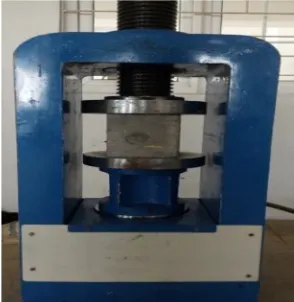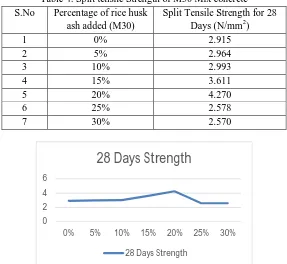A Comparative of
the Study on Mechanical
Strength Properties by Replacing Cement with Rice
Husk Ash
V.N. Kalyani
1,
A.S. Swetha Sri
2, A. Naga Sai
31
Asst. Professor, Department of Civil Engineering, Aditya College Of Engineering & Technology, Suramaplem, Kakinada, A.P., India.
2
Asst. Professor, Department of Civil Engineering, Aditya Engineering College, Suramaplem, Kakinada, A.P., India. 3
Asst. Professor, Department of Civil Engineering, Aditya College Of Engineering & Technology, Suramaplem, Kakinada, A.P., India.
Abstract: Carbon dioxide emissions increase due to air pollution and landfill problems caused by improper production of cement production and rice ash (RHA). To alleviate these problems, RHA has been used as a cement additive in concrete manufacturing. RHA is obtained by burning rice husk, which is a large amount of agricultural waste available in rice mills. In this paper we focus on M30 concrete to determine various mechanical properties. Rice husk ash is used to replace cement in a certain proportion, such as 0%, 5%, 10%, 15%, 20%, 25% and 30% in each series. Concrete cubes, cylinders are cast and tested in the laboratory. The best replacement ratio was found by testing. Compressive strength test of concrete cubes, tensile strength test of cylinders
Keywords: Rice husk ash, compression strength, split tensile strength and flexural strength.
I. INTRODUCTION
The use of industrial waste or secondary materials has facilitated the production of cement and concrete in the construction sector. Various by-products and wastes are being produced in various industries. Pour or dispose of waste can cause environmental and health problems. Therefore, the recycling of waste has great potential in the concrete industry. By-products such as fly ash, silica gel sinks and slag have been considered waste for many years. Concrete made from this material shows improved workability and durability compared to ordinary concrete and has been used to build electricity, chemical plants and underwater structures. In recent decades, intensive research has been conducted to explore all possible reuse methods. Construction waste, blast furnaces, steel slag, fly ash and bottom ash have been accepted in many places as an alternative to embankments, roads, pavements, foundations and construction, Teikthyeluin et pointed out in the production of ordinary Portland cement. Al (2006).
Rice husk ash is a by-product material produced from rice husks obtained by burning. The structural stability and strength properties of concrete make it the most widely used material in the construction industry. All the components of concrete are obtained from the earth's crust, thus depleting the earth's nature reserves. On the other hand, human activities are producing solid waste in the form of industrial waste and agricultural waste, which is about 2,500 tons per year. However, according to recent research, it has been concluded that these organic and organic wastes can produce many by-products that can be used in various forms. Common wastes are fly ash, rice husk ash, silica fume, ground granulated blast furnace slag and demolition building materials. Due to recent advances in construction technology, the consumption of mineral admixtures in cement and concrete has increased significantly. This increase in demand has been met by partial replacement of cement with auxiliary cement materials. By using industrial by-products as an alternative to cement SCM, significant cost and energy savings can be achieved. The use of industrial waste in concrete is an environmentally friendly method of treating waste that would otherwise pollute the environment.
and serves this purpose. If the concrete structure is not properly cured, voids are formed therein. RHA is finer than cement and has a particle size of 25 microns, filling the gap between the cement and the aggregate, making the concrete denser and stronger.
Aggregates are considered to be one of the main components of concrete because they account for more than 70% of the concrete matrix. In many countries, there is a lack of natural aggregates suitable for construction, while in other countries, as the demand for the construction industry increases, the consumption of aggregates increases. In order to reduce the dependence of natural aggregates as the main source of aggregate in concrete, artificial aggregates and artificial aggregates produced by industrial waste provide an alternative to the construction industry. Therefore, the use of aggregates in industrial waste can replace natural and artificial aggregates. If no suitable replacement aggregates are used in the near future, the global concrete industry will consume between 800 and 1.2 billion tons of natural aggregate per year after 2010. Such a large amount of natural aggregate consumption will cause damage to the environment. In the past few decades, the production of waste and by-products has increased rapidly due to the exponential growth rate of population, the development of industry and technology, and the growth of consumerism.
Another major advantage of using this material is the reduction in construction costs. Rice husk ash is one of the materials considered to be waste materials. As part or all of the substitute for cement or aggregate, it has broad prospects in the construction industry. It is a by-product obtained during the process of refining rice.
Property Typical Values
Colour Grey
Grain shape Irregular
Specific gravity at 25oC 3.61
Bulk Density at 25oC 1.75 tonnes/m3
pH 7.0
Burning temperature 400-800oC
Weight raise on ignition 4%
Moisture content 2%
Rice husk ash has a concentration of Sio2 and Fe2O3 compared to OPC. Compared with the chemical composition of natural pozzolans of ASTM C 618-99, the sum of three oxides (silica, alumina and iron oxide) in rice husk ash is close to 95%, exceeding 70% of N-grade raw materials. Number of digits. Calcination of natural volcanic ash. Therefore, rice husk ash is expected to have good potential for producing high quality volcanic ash. The table shows the chemical composition of rice husk ash obtained from the National Cement and Construction Council.
Chemical Composition:
S. No Component Symbol (%)
1 Silica SiO2 93.80
2 Alumina Al2O3 0.74
3 Ferric Oxide Fe2O3 0.30
4 Titanium oxide TiO2 0.10
5 Calcium Oxide CaO 0.89
6 Magnesium Oxide MgO 0.32
7 Loss of Ignition LOI 3.37
8 Sodium Oxide Na2O 0.28
II. EXPERIMENTAL PROGRAM
A. Mix Proportions
The mixing ratio is adopted according to IS-10262-2009. For the test sample level 53 port land cement, natural river sand and coarse aggregate, copper slag from plants is being utilized. The experimental procedure was designed to study the mechanical properties of concrete and to add fiber concrete to M30 and M40 grade concrete.
[image:3.612.232.379.272.423.2]1) Compressive Strength of Cubes: A cubic compressive strength test was performed on a 150 mm sized cube at 7 days and 28 days according to IS 516. The compression test is the most common test performed on hardened concrete, in part because it is easy to test, in part because most of the desirable properties of concrete have a qualitative relationship with its compressive strength. The compressive strength test sample has a size of 150 mm x 150 mm x 150 mm. After 28 days of curing, the samples were tested at a capacity of 2000 kN. The compression test is performed on a cubic or cylindrical sample. Prisms are also used, but they are not common in our country. Sometimes the compressive strength of concrete is determined using the portion of the beam tested in the bend. After the bending failure, the ends of the beam remain intact, and because the beam typically has a square cross section, the partial beam can be used to find compressive strength. The length of the cylindrical specimen is equal to twice the diameter.
Table 2: Compressive Strength of M30 Mix concrete
S.No
Percentage of rice husk ash added (M30)
7 Days(Mpa)
28 Days(Mpa)
1 0% 31.910 37.195
2 5% 34.900 37.795
3 10% 35.660 38.065
4 15% 36.265 39.330
5 20% 37.905 40.770
6 25% 30.550 32.660
7 30% 29.693 26.705
0 50
0% 5% 10% 15% 20% 25% 30%
Compression Strength for 7
Days & 28 Days
2) Split Tensile Strength of Cylinders: Determining the tensile strength of the concrete member is necessary to determine the load at which the concrete member may break. Cracks are a form of tension failure. Split tensile strength is an indirect method for finding the tensile strength of concrete. The tensile splitting strength and 18 cylinders of a 150 mm diameter and 300 mm height cylinder were tested. The test was carried out by placing a cylindrical sample horizontally between the loading surfaces of the compression tester, and applying a load until the cylinder failed.
Table 4: Split tensile Strength of M30 Mix concrete S.No Percentage of rice husk
ash added (M30)
Split Tensile Strength for 28 Days (N/mm2)
1 0% 2.915
2 5% 2.964
3 10% 2.993
4 15% 3.611
5 20% 4.270
6 25% 2.578
7 30% 2.570
Graph 3 Split tensile strength of M30 & M40 Grade mix with various % of fibers at the age of 28 days.
III. CONCLUSIONS
Based on the experimental results presented in this paper, the following conclusions can be drawn:
A. The use of rice husk ash in concrete provides additional environmental and technical benefits for all industries. Partial
replacement of rice hull ash in cement can reduce the cost of manufacturing concrete.
B. Replacement of rice husk ash (30% cement replacement) can increase the weight of concrete samples to a maximum of
15-18%.
C. The results of compressive strength indicate that the strength of the concrete is increased by 20% relative to the percentage of
rice husk ash added to the weight of the cement.
D. Increased compressive strength and split tensile strength due to high toughness of rice husk ash
E. The highest compressive strength obtained is 40.77 (replacement rate is 20%). Substituting 30% cement with rice hull ash
resulted in lower compressive strength compared to the control mixture. However, for different alternatives, the change in intensity is negligible.
F. The highest split tensile strength obtained is 4.270 (20% replacement). Substituting 30% cement with rice hull ash resulted in
lower split tensile strength compared to the control mixture. However, for different alternatives, the change in intensity is negligible.
REFERENCES
[1] A.L.G. Gstaldini, M.P. Dasilva, “ Total shrinkage, chloride penetration and compressive strength of concrete that contains clear colored rice husk ash ”. [2] A.L.G. Gastaldini, G.C. Isaia, “ Influence of the use of rice husk ash on the electrical resistivity of concrete: A technical and economic feasibility study ”,
Construction and Building Materials. 0 2 4 6
0% 5% 10% 15% 20% 25% 30%
28 Days Strength
[4] Hwang chao-lung, Chen chun-Tsun “Effect of rice husk ash on the strength and durability characteristics of concrete”, Construction and Building Materials. [5] IS: 10262-2009, Recommended Guidelines for Concrete Mix Design, Bureau of Indian Standards, New Delhi, India.
[6] Jaosephinalex, Dhanalakshmi, “Experimental investigation on rice husk ash as cement replacement on concrete production”, Construction and Building Materials.
[7] Javad Trokaman, “Using wood fibre waste, rice husk ash and lime stone as cement replacement for light weight concrete”, Construction and Building Materials.
[8] MahBoubehZahedi, “Evaluation of the mechanical properties and durability of cement mortars containing Nano silica and rice husk ash under chloride ion penetration”, Construction and Building Materials.
[9] M.S. Shetty, “Concrete Technology Theory and Practice”, S. Chand & Company, New Delhi.
[10] Ngeyen vantuan, Guang Ye, “The study of using Rice Husk Ash to produce ultra-high performance concrete”, Construction and Building Materials. [11] P. Chindaprairt, S. HomWuptiwong, “Strength and water permeability of concrete containing palm oil fuel ash and rice husk-bark ash”, Science Direct. [12] Compressive strength test of concrete (IS: 516-1959), split tensile strength test of concrete (IS: 516-1959).
[13] Sudisht Mishra, “Effect of Rice Husk Ash on Cement Mortar and Concrete”, Faculty Civil Engineer. Dept NERIST, Itanagar, Prof (Dr.) S. V. Deodhar, Principal, SSVPS BSD College of Engineering, Dhule.
[14] Veera Horsakulthai, Santi Phiuvanna, “Investigation on corrosion resistance of bagasse rice husk blended cement concrete by impressed voltage ”, Construction and Building Materials.

